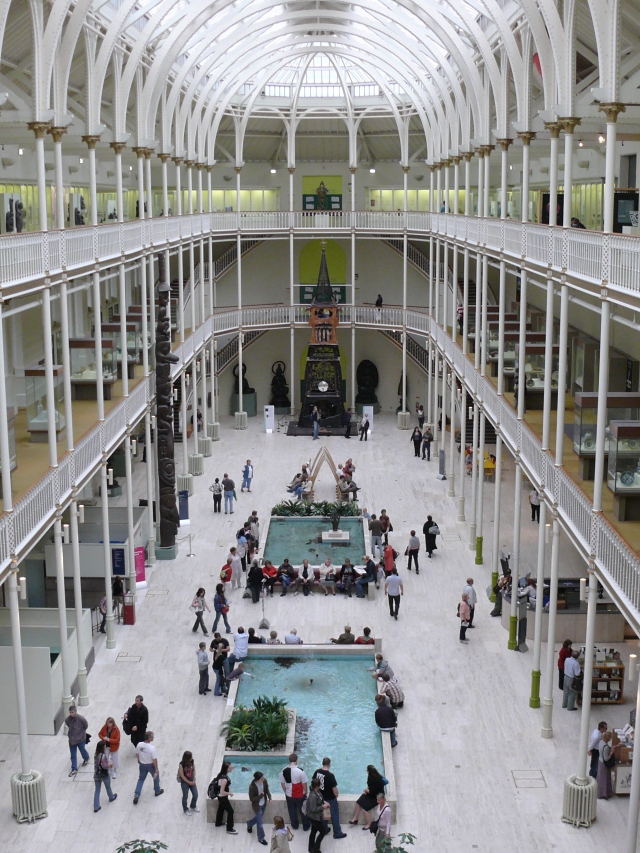
The museum appears at the top of the hill; a great round tower. The lobby is stark and ultramodern giving no hint of the treasures that lie inside. As we plan on spending much of the day here, we will need lunch and study a menu posted in the lobby for Tops Restaurant, appropriately situated at the top of the museum. There's supposed to be an incredible view of the city from the restaurant but the prices on this menu soar to incredible heights as well. Not a big deal right now, as we're not hungry yet. We move on to the interior of the museum.
The levels of the museum are arranged chronologically. Level 0 has exhibits and films on the formation of the landscape, which is more interesting than I thought it would be, prehistoric times and extinct wildlife. Dioramas with touch pads provide detailed information and sound effects. We wander through, oohing and ahing with a group of school children.
Scotland's early inhabitants can be found here too. Roman, Viking and Pictish artifacts are on this level, including an exquisite woven woolen hood from Orkney, dated from the second to fifth century, remains of Viking boats found on Eigg in Inverness-shire and face masks which formed parts of helmets worn by Roman soldiers.
Levels One and Two are where we spend most of our time. Here we find the best of the best from the abbeys we have already toured in the borders; the most magnificent carvings that have fallen from the structures over the years are found here. There is also an impressive collection of barbaric jewelry – torques and bracelets, rings and earrings – all displayed on larger than life modern sculptures.
We pass through a corridor which is engraved with words from the Declaration of Arbroath and a tingle creeps up my spine. The Gaels exhibit is just to the left and I am rendered speechless, wandering in awe among the claymores, dirks and highland brooches. One thing that holds me mesmerized for quite some time is a clarsach, a Celtic harp, one of only three remaining from this era. The carving around the base is exquisite. A touchpad provides music that sends me back in time.
A ceremonial sword that must have certainly been borne by several men towers over me. A quaich which was made after the Scottish victory at Bannockburn holds my attention. Precious stones and a gold lion decorate the bottom. A 16th century iron beheading machine "The Maiden" looms above us. Gold and silver weapons, coins, rings and brooches fill display cases.
Portions of a medieval church are reconstructed and relics from the abbeys and churches that were spirited away during the Reformation are here as well, finally completing the picture in my mind the wealth of these establishments. Gold goblets and crosses encrusted with jewels glitter behind glass. Overhead are painted murals and carvings.
This museum truly is Scotland's treasure house. There are artifacts from so many eras here – over eight hundred years of government, tradition and warfare, arts, crafts, culture and religion from the early saints to the Reformation.

The National Museum of Scotland, Edinburgh, Scotland, was formed in 2006 with the merger of the new Museum of Scotland, with collections relating to Scottish antiquities, culture and history, and the adjacent Royal Museum (so renamed in 1995), with collections covering science and technology, natural history, and world cultures. The two connected buildings stand beside each other on Chambers Street, by the intersection with the George IV Bridge, in central Edinburgh.
The National Museum incorporates the collections of the former National Museum of Antiquities of Scotland. In addition to the national collections of Scottish archaeological finds and medieval objects, the museum also contains artifacts from around the world, encompassing geology, archaeology, natural history, science, technology, art, and world cultures.
Read more about the National Museum of Scotland at Wikipedia.